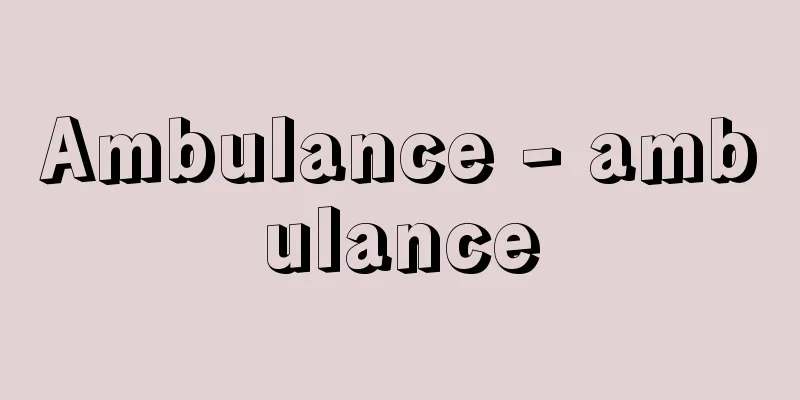Ambulance - ambulance

|
A vehicle equipped to transport injured or sick people to a medical institution in an emergency. Emergency personnel provide first aid until the injured or sick person receives treatment at the medical institution. Also called an ambulance. [Masaaki Okamura and Kazuhiro Kubota] historyThe beginning of ambulances can be found in records from the 18th century Napoleonic Wars, when Jean Larrey, a military surgeon for the French Army, used a horse-drawn carriage to provide medical care to wounded soldiers on the battlefield. In civilian life, the first recorded use of a horse-drawn carriage to transport patients was in 1869 at a hospital in Cincinnati, USA. Later, Bellevue Hospital in New York City did the same in 1870, and London was the first in 1879, both of which were horse-drawn ambulances. The first ambulance was used at Michael's Hospital in Chicago in 1899. In Japan, the Osaka branch of the Japanese Red Cross Society was the first to introduce ambulances in 1931 (Showa 6), and Yokohama City was the first fire department to introduce one in 1933, followed by Nagoya City and Kyoto, and by 1935, six ambulances were deployed to the Fire Department of the Tokyo Metropolitan Police Department. After that, with the development of motorization, especially after the Second World War, ambulances were rapidly established in various countries around the world, and in Europe and the United States, each city has hospitals, the Red Cross, fire departments, or volunteer organizations provide ambulance services as part of their public health services. Some hospitals also operate their own ambulances. In Japan, the Fire Service Act of 1963 required certain cities, towns, and villages to equip their fire stations with ambulances as part of their fire service, and as of April 2011, there were 6,003 ambulances in operation. [Masaaki Okamura and Kazuhiro Kubota] Structure and EquipmentAmbulances must be equipped with warning lights and a siren that meet the standards for emergency vehicles set out in the Road Transport Vehicle Act, be painted white, and also meet other conditions, such as being able to accommodate three or more emergency personnel who have acquired the knowledge and skills necessary for emergency work, such as first aid, and two or more injured people, being able to store one or more beds and two or more stretchers, and having enough volume for the personnel to carry out their duties, and being equipped with the equipment necessary to carry out emergency services. The ambulance is equipped with equipment such as a blood pressure monitor and electrocardiogram for observing the injured person, an automated external defibrillator for life-saving procedures, a complete set of infusion and medication, and an endotracheal tube, as well as other equipment necessary for communication and rescue.The ambulance team is made up of emergency personnel who have completed training in emergency work, such as the basics of emergency work and emergency medical care, and first aid for specific injuries and illnesses. Furthermore, helicopters were used to transport seriously ill patients during the Great Hanshin-Awaji Earthquake in January 1995, and their necessity and usefulness were recognized. In light of the fact that helicopters are deployed nationwide, the transportation of injured and sick people by helicopters owned by prefectures and large fire departments was also included as an emergency service in 1998 under Article 44 of the Enforcement Order of the Fire Service Act. In addition, the crew, excluding the pilot, must be made up of two or more emergency personnel, and they are loaded with the same equipment as ambulances. In order to improve first aid (pre-hospital care) at the scene of an emergency and during transport, which was pointed out as being insufficient compared to Europe and the United States, the national certification for emergency medical technicians was established in 1992 under the Emergency Medical Technician Act (Act No. 36 of 1991). To become an emergency medical technician, one must pass a national examination and be licensed by the Minister of Health, Labor and Welfare. During transport to a medical institution by ambulance, emergency medical technicians can perform advanced first aid, such as intubation and administration of medication, on injured or sick people who have stopped breathing or have stopped heartbeat, that is, cardiopulmonary arrest, under the direction of a doctor, which cannot be done by ordinary emergency personnel. [Kubota Kazuhiro] Reporting and Action SystemAn ambulance can be called when an injured or sick person or a person showing serious symptoms occurs due to an accident caused by a disaster, an accident outdoors or in a public place, or an accident indoors. In Japan, 119 is used as a dedicated fire alarm number for fires and emergency situations. When a call is made to 119, it is received by the fire command center at the fire department headquarters, and an ambulance is dispatched from the fire station closest to the scene of the emergency accident. The introduction of a system that notifies the fire department headquarters of the location of the call when a 119 call is made helps the ambulance to respond quickly. The fire command center receives reports of the condition of the injured person and the situation at the scene from ambulances under its control by radio telephone, and supports the activities of the ambulance team based on that information. In addition, the fire command center and emergency hospitals communicate with each other about the situation and condition of the injured person by one-touch wired telephone, and a system is in place to quickly admit them to medical institutions based on information collected in real time by the emergency medical information system. In addition, some fire departments have doctors stationed in their fire command centers 24 hours a day to provide instructions and advice to emergency teams on first aid and the selection of medical institutions. [Kubota Kazuhiro] "Firefighting and Life - Basic Concepts for Emergency Activities" by Yamada Takaharu (1974, Tokyo Horei Publishing)" ▽ "Emergency Talk - What can you do before the ambulance arrives" by Aoki Katsunori (1999, Shizuoka Shimbun)" ▽ "Approach to Emergency Field Studies" edited by Yamamoto Isshunen, supervised by Ishihara Susumu and Mashiko Kunihiro (2008, Nagai Shoten)" ▽ "Fire and Disaster Management Agency, 'Fire and Disaster Management Agency White Paper' Annual Edition (Gyosei)" [Reference items] | | |In addition to transporting injured or sick people, the vehicle is equipped with materials and equipment that enable emergency medical technicians to carry out advanced treatment and life-saving activities inside the vehicle . High-standard ambulance It is also called Super Ambulance. In addition to transporting patients, the vehicle can be expanded on both sides to function as a first aid station . Special Ambulance Source: Shogakukan Encyclopedia Nipponica About Encyclopedia Nipponica Information | Legend |
|
負傷者、病人を緊急に医療機関に運べるように装備された自動車のこと。救急隊員が医療機関で治療を受けるまでの応急処置を行う。救急自動車ともいう。 [岡村正明・窪田和弘] 歴史救急車の始まりは、18世紀のナポレオン戦争のとき、フランス陸軍の軍医ジーン・ラリーが戦場で馬車を使って傷兵の救護をした記録に求められる。市民生活のなかでは1869年にシンシナティ市(アメリカ)の病院が患者の輸送に馬車を使ったのが記録上最初である。その後、ニューヨーク市は、1870年ベルビュー病院に行わせ、ロンドンは1879年が初めで、いずれも救急馬車である。最初の救急車は1899年、シカゴのミハエル病院で使われたという。日本では、日本赤十字社大阪支部が1931年(昭和6)に開始したのが最初で、消防機関では1933年横浜市が初めて導入、その後名古屋市、京都と続き、1935年には警視庁消防部に6台の救急車が配置された。その後、モータリゼーションの発達とともに、世界各国とも、とくに第二次世界大戦後、急速に救急車が整備され、欧米などでは各都市が公衆保健業務の一つとして、病院、赤十字、消防あるいは篤志団体にこの業務を実施させている。また、病院独自に救急車を運用しているところもある。日本では、1963年(昭和38)消防法で一定の市町村に消防業務として救急車を消防署に備えさせ、2011年(平成23)4月時点で6003台の救急車を保有している。 [岡村正明・窪田和弘] 構造・装備救急車は道路運送車両法で定められた緊急自動車の規準に適合する警光燈およびサイレンを備え、車体の塗色を白色とするほか、救急業務に必要な応急処置などの知識、技術を修得した救急隊員3人以上および傷病者2人以上を収容できること、ベッド1台以上および担架2台以上を収納し、かつ隊員が業務を行うことができる容積を有するものであること、救急業務の実施に必要な資器材を備えていることなどの条件を満たさねばならない。 傷病者の観察を行うための血圧計や心電計、救命処置のための自動体外式除細動器、輸液・薬剤セット一式、気管内チューブ等のほか、通信や救出等に必要な資器材が救急車に積載されてあり、救急業務および救急医療の基礎、傷病別の応急処置など、救急業務に関する講習を修了した救急隊員で救急隊が構成される。 また、1995年(平成7)1月の阪神・淡路大震災の際にヘリコプターが重症患者の搬送等に使われ、その必要性、有用性が認識されたこと、および全国的に配備されていることを踏まえ、1998年には都道府県や大規模な消防本部が保有するヘリコプターによる傷病者搬送も救急業務として、消防法施行令第44条に位置づけられた。なおパイロット以外の乗員は救急隊員2人以上で編成しなければならないとされており、救急車と同様な資器材が積載されている。 欧米に比べて十分ではないと指摘されていた救急現場および搬送途上における応急処置(プレホスピタル・ケア)の充実を図るため、救急救命士法(平成3年法律第36号)に基づき、1992年に救急救命士の国家資格が設けられた。救急救命士になるためには、国家試験に合格し、厚生労働大臣の免許を受ける必要がある。救急車による医療機関への搬送途上、医師の指示のもとに、呼吸や心臓の止まった、いわゆる心肺機能停止状態の傷病者に対して気管挿管、薬剤投与など一般の救急隊員ではできない高度な応急処置を行うことができる。 [窪田和弘] 通報と活動システム災害による事故、屋外または公衆の出入りする場所での事故、屋内での事故による傷病者や重篤な症状を示す急病人が発生した場合に、救急車を呼ぶことができる。日本では火災、救急などの火災報知専用電話として119番が用いられている。119番通報すると、消防本部にある消防指令センターで受信され、救急事故現場にもっとも近い消防署から救急隊が出動する。なお、119番通報時に発信場所の位置情報を消防本部に通知するシステムの導入は、救急隊の迅速な出場に役立っている。消防指令センターは管制下にある現場の救急車から無線電話で傷病者の状態や現場状況等の報告を受け、それをもとに救急隊の活動をサポートする。また、消防指令センターと救急病院とはワンタッチの有線電話で傷病者の状況、病状を相互に連絡しあい、救急医療情報システムでリアルタイムに収集した情報をもとに、医療機関への迅速な受入れを行う体制がとられている。さらには、活動中の救急隊に応急処置や医療機関の選定などの指示、助言をするため、消防指令センターに医師を24時間配置している消防本部もある。 [窪田和弘] 『山田高治著『消防と生命――救急活動についての基本的な考え方』(1974・東京法令出版)』▽『青木克憲著『救急の話――救急隊が着くまでに、あなたは何ができる?』(1999・静岡新聞社)』▽『石原晋・益子邦洋監修、山本五十年編『救急現場学へのアプローチ』(2008・永井書店)』▽『消防庁編『消防白書』各年版(ぎょうせい)』 [参照項目] | | |傷病者の搬送だけでなく、救急救命士が車内で高度な処置や救命活動を行うための資材・機器を備えている©Shogakukan"> 高規格救急車 スーパーアンビュランスともいう。患者搬送のほか、車体を左右に拡張することで救護所としての役割を果たす©Shogakukan"> 特殊救急車 出典 小学館 日本大百科全書(ニッポニカ)日本大百科全書(ニッポニカ)について 情報 | 凡例 |
<<: Emergency rice field - Emergency rice field
>>: Nine Palace Gods - 九宮希神 (English)
Recommend
Ihara Tsurunaga
... Haikai. Edited by Ihara Tsurunaga (Saikaku). ...
Greater North American short-tailed shrew
A short-tailed shrew commonly found in the forests...
William of Ockham
...theologian and logician. Born in Surrey, near ...
Frederik I
…The next king, Hans (1481-1513), founded the Uni...
Interpretation and execution system
...Software that performs the necessary translati...
rhythmos
…Rhythm is often translated as rhythm, rhythm, or...
Veres P.
… [Socialist period] After World War II, Hungary ...
confrerie (English spelling)
...Strikes against employers were often launched,...
Acrocephalus bistrigiceps (English spelling) Acrocephalusbistrigiceps
…[Higuchi Hiroyoshi]. … *Some of the terminology ...
Toluca - Toluca (English spelling)
The capital of the State of Mexico in central Mex...
Shallow Well - Aside
A critical biography of poet Hagiwara Sakutarō by ...
Rayograph
…In 1921, he went to Paris for the first time and...
Hysteresis
Also known as hysteresis. The magnitude of magneti...
Arc lamp
Although it is sometimes used as a general term f...
Secondary hemorrhage
…However, if the blood clot becomes dislodged or ...






![Ichikawa [town] - Ichikawa](/upload/images/67caec44a6ff8.webp)


